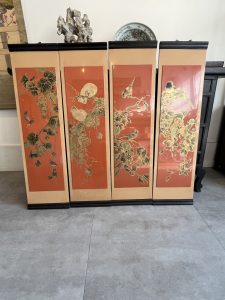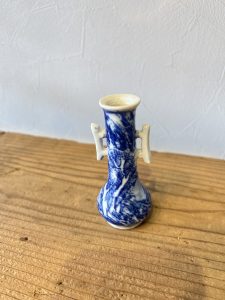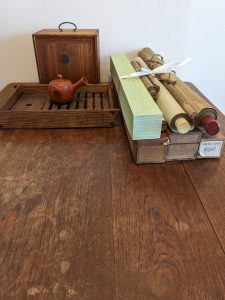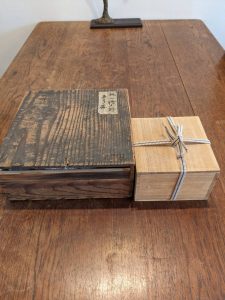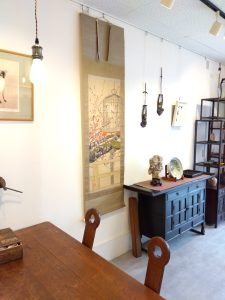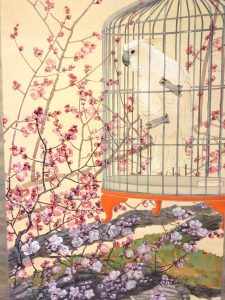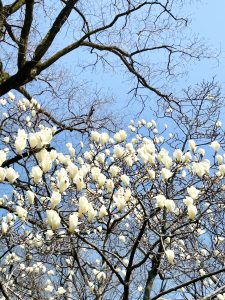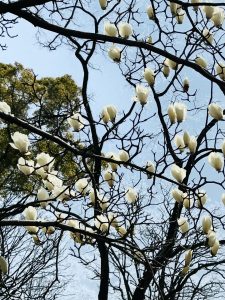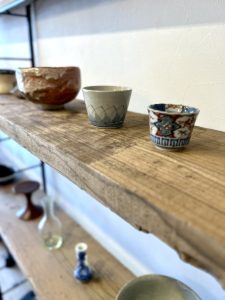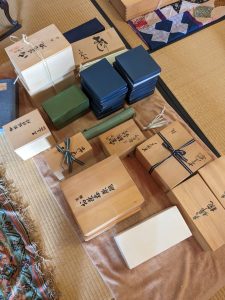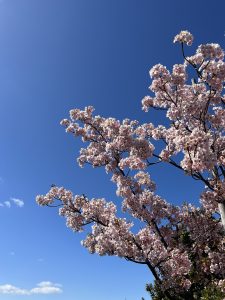あの形が一番なのでしょうか…(愛知県名古屋市千種区姫池通 骨董品買取 古美術風光舎)
2024.03.20
みなさまこんにちは、スタッフTでございます。
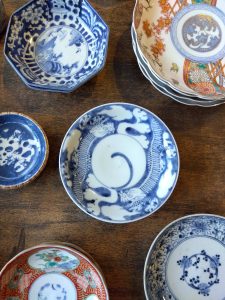
朝からの冷たい雨も上がり、名古屋のお天気は回復してまいりました。
雨が降るたびにいつも思います。やはり傘ってあの形が一番なのでしょうか……
みなさまも一度は考えたことがあるかもしれません。私ももれなく子供の頃に考えたことがある「もっと違う形の傘」の発明。手を塞がず、靴がびしょ濡れにならない傘があったらいいなと。そして子供心に、なぜ傘は昔から形がほとんど変わらないのだろうか…と思っておりました。
調べてみますと、傘の起源は、遥か4000年も前にあったとされています。 古代ギリシャでは、高貴な身分の人が従者に持たせて歩いたそうで、当初は主に日除けとして用いられました。 開いたり閉じたりすることができる、画期的な開閉式の傘(日傘)が誕生したのは13世紀のイタリアと言われています。
その後、スペイン、ポルトガル、フランスなどヨーロッパに広がっていき、多くの貴婦人に愛用され、18世紀頃にはイギリスで現在の構造(開閉式)の日傘が開発されましたが、雨が降っても傘はささずに濡れていたそうです。1928年にはドイツで折りたたみ傘が登場しました。
日本でも江戸から明治時代の普及当初は、主に日射を避ける日傘として用いられていましたが、その後日本独自の構造的進化も見られ、雨に対して使うことが多くなっていったということです。
雨や雪、直射日光などが当たらないように頭に被る道具「かさ」として、日本で最も古くに登場したのは、「かぶりがさ」として知られる笠。 最古の歴史書である「日本書紀」に登場し、古墳時代には笠をかぶった埴輪なども残されているようです。
材料は、イグサ、ヒノキ、竹などが使われ、現在も屋外の労働に、雨や日除けとして広く東南アジア各地でも使用されているものだそうです。 一方、軸を中心に頭の上に広げる「傘」が日本に伝来した時期については詳しく分かっていませんが、古墳時代の後期、欽明天皇の時代には、百済から仏具の傘(天蓋)が日本に献上された記録が残っているようです。
平安時代以降には製紙や竹細工の技術の進歩によって、和紙に油を塗り防水性をもたせ、さらに開閉できる「和傘」がつくられるようになりました。
和傘は柿渋や油などを塗って防水加工した和紙などが用いられています。 その和紙を数十本の骨組みで支える構造で、柄と骨部分には主に竹や木が使用されています。
種類としては、番傘(ばんがさ)や蛇の目傘(じゃのめがさ)、端折傘(つまおれがさ)などが日本で広く知られています。
日本に「洋傘」が持ち込まれた当初の江戸時代の傘は、とても高価なため、一般庶民には手の出せない代物で、使用していたのは、武家、医師、洋学者といった一部の人たちでした。
明治時代に入ると、文明開化とともに洋傘も普及し始め、明治元年(1868年)に刊行された江戸(東京)の地誌「武江年表」には、「庶民にも洋傘が普及し始めた」ことが記されています。
1900年代、傘は進化を遂げます。1928年、ドイツのハンス・ハウプトが折りたたみ傘を発案しました。世界的に大ヒットをおさめた折りたたみ傘は、現在世界でもっともメジャーな傘のスタイルとなりました。その後、浅草の傘メーカー「ホワイトローズ」が、1958年にビニール傘を発明。国内で人気を博したビニール傘は1964年の東京オリンピックを機に世界へと名を馳せることとなりました。
ほとんど形が変わっていないと思っておりました「傘」ですが、画期的な傘がありました。
閉じている時は普通の傘と変わらないのに、開くと後ろ側だけ長い傘があるのです。形のイメージとしては、保育園の園児たちが被っているカラー帽子のように首までカバーできるイメージです。
丸い傘ですと、実質半分の面積しか使えず、背中や鞄がはみ出て濡れてしまいがちですが、後ろ部分が伸びているので、背中や鞄が濡れずにすむという画期的な傘です。いつもそう思っていたので、それを具体化して商品化された開発者の方に拍手を送りたくなる気持ちになりました。
他にも、濡れた傘をくるくると纏める時の、手が濡れる煩わしさを解消する「ベルトで留めなくて良い傘」や、「閉じたときに濡れた部分が内側になる」というユニークな傘もありましたよ。
もしかしたら、今後もっと進化した傘に出会えるかもしれませんね。
ではでは、また。
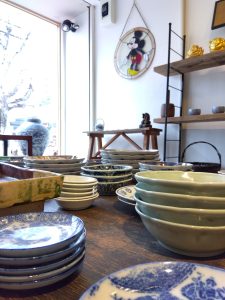
Hello everyone, this is Staff T.
The cold rain from this morning has stopped and the weather in Nagoya has recovered.
Whenever it rains, I always think, “I wonder if umbrellas are the best in that shape. I wonder if that shape is the best for umbrellas. ……
You may have thought about this at least once. I too have thought about the invention of a “different shaped umbrella” when I was a child. I thought it would be nice to have an umbrella that didn’t block my hands and didn’t get my shoes soaking wet. And in my childish mind, I wondered why umbrellas have remained almost unchanged in shape since ancient times….
Research shows that umbrellas originated as far back as 4,000 years ago. In ancient Greece, it is said that people of noble rank walked around with it carried by their attendants, and it was initially used mainly as a sunshade. It is said that it was in Italy in the 13th century that the revolutionary retractable umbrella (parasol), which could be opened and closed, was born.
In 1928, the folding umbrella was introduced in Germany.
In Japan, when it first became popular in the Edo and Meiji periods, it was mainly used as a parasol to protect the wearer from the sun, but later, with the evolution of Japan’s unique structure, it was used more and more against rain.
As a “kasa,” a tool worn over the head to protect it from rain, snow, and direct sunlight,
The earliest kasa to appear in Japan was the kasa known as the kaburi-gasa. It appears in the oldest history book, “Nihon Shoki (Chronicles of Japan),” and haniwa (clay figurines) with kasa headgear were also found in the Kofun period.
The materials used for the kasa include Igusa (rush grass), cypress, and bamboo, and it is still widely used in Southeast Asia for outdoor work and as a protection from rain and sun. On the other hand, it is not known in detail when the umbrella, which is spread over the head around a shaft, was introduced to Japan, but there is a record that a Buddhist umbrella (canopy) was presented to Japan from Baekje during the reign of Emperor Kinmei in the late Kofun period.
After the Heian period (794-1185), advances in papermaking and bamboo crafting techniques led to the production of “wagasa,” a waterproof umbrella made of Japanese paper coated with oil that could be opened and closed.
Wagasa is made of waterproofed Japanese paper coated with persimmon tannin or oil. The handle and bones are mainly made of bamboo or wood.
The most widely known types of umbrellas in Japan are the bangasa, the janomezasa, and the tsumaoregasa.
When Western-style umbrellas were first introduced to Japan in the Edo period (1603-1868), they were so expensive that the general public could not afford them, and only a few people such as samurai families, doctors, and Western scholars used them.
In the Meiji era (1868), Western-style umbrellas began to spread with the civilization’s opening to the outside world, and “Takeh Nenpyo,” a geographical journal of Edo (Tokyo) published in the first year of Meiji (1868), states that “Western-style umbrellas began to spread among the general public.
In the 1900s, the umbrella evolved: in 1928, Hans Haupt of Germany invented the folding umbrella. The folding umbrella became a worldwide hit and is now the most popular umbrella style in the world. Later, the Asakusa umbrella manufacturer White Rose invented the vinyl umbrella in 1958. The vinyl umbrella, which gained popularity in Japan, became famous around the world after the 1964 Tokyo Olympics.
I had thought that the shape of umbrellas had hardly changed, but there is an epoch-making umbrella.
When closed, it is no different from an ordinary umbrella, but when opened, it has a long umbrella only on the back side. The image of the shape is that of a colored hat worn by children at a nursery school, which covers the whole of the child’s neck.
A round umbrella can only cover half the area, and the back or bag tends to get wet. I always thought so, so I felt inclined to applaud the developer for materializing and commercializing it.
There are also unique umbrellas that “do not require a belt to fasten” to eliminate the hassle of wet hands when wrapping wet umbrellas, and “the wet part becomes the inside when closed”.
Perhaps we will see more advanced umbrellas in the future.
See you soon.
*******************
ご実家の整理やお片付けなどをされている方のご相談などが多くございます。
お片付けなどくれぐれもご無理のないようになさってくださいませ。
風光舎では古美術品や骨董品の他にも絵画や宝石、趣味のお品など様々なジャンルのものを買受しております。
お片付けをされていて、こういうものでもいいのかしらと迷われているものでも、どうぞお気軽にご相談下さいませ。
また風光舎は、出張買取も強化しております。ご近所はもちろん、愛知県内、岐阜県、三重県その他の県へも出張いたします。
まずは、お電話お待ちしております。
愛知県名古屋市千種区姫池通
骨董 買取【古美術 風光舎 名古屋店】
TEL052(734)8444
10:00-18:00 OPEN

